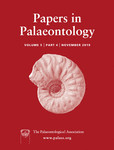Reg. Charity No. 1168330

The collision between India and Eurasia in the mid‐Palaeogene facilitated terrestrial floristic exchange. However, due to the complexity of this geological event and scarcity of fossil record, the plant migration patterns between the two plates are still highly debated. In this study, we focus on the Oligocene floristic exchange between India and Pan‐Indochina mainly based on a carpological study of Annonaceae, an emblematic family unique in its pantropical distribution and frugivore‐based dispersal strategy. A new seed species, Anonaspermum orientalis sp. nov., is described from the upper Oligocene Yongning Formation of Guangxi, southern China. The species represents the earliest known occurrence of this family in Pan‐Indochina. The specimens are characterized by ovate–elliptic seed shape, thicker seed testa, two‐lobed organization, lamelliform rumination and an obvious cone‐like plug. The palaeobiogeographical reconstruction of Annonaceae indicates that the most parsimonious dispersal scenario for the annonaceous taxon from the late Oligocene of China is the Out‐of‐India route, in parallel with other plant genera inferred to have migrated between India and Pan‐Indochina during that period.